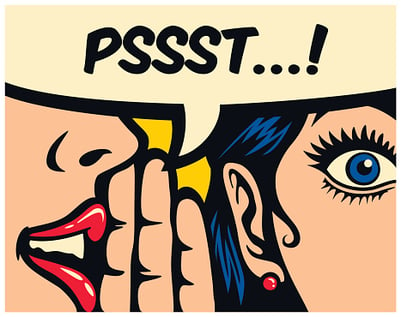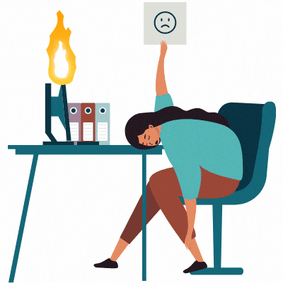This year, the propane tank that powers my home ran so low that my heater started to sputter… in the middle of the most relentlessly cold winter we’ve seen in years. The only thing we could do was turn the heat way down to conserve, just warm enough to keep the pipes and kids from freezing. We’re fine now, thanks for asking.
Unfortunately, this was only the latest in a string of mini-disasters, each one silently draining my mental and emotional energy until I, myself, started to sputter. The only thing I could do was turn my expectations way down, only expending enough energy to keep the essentials taken care of. Dinner? Pizza night again. Laundry? Here’s the Febreze. The deadline for this article? Missed it by a month.
It’s called burnout. And it’s a growing problem in the workplace – probably among your own employees.
You probably wouldn’t be surprised that workplace stress and burnout skyrocketed during 2020 through the depths of the pandemic and in 2021 as the effects stretched longer and longer than anyone predicted. But then, it was SUPPOSED to get better.
Spoiler alert: it didn’t. This is bad news for both employees and employers alike.
Managing employee stress has long fallen under the purview of Human Resources. However, that task is growing larger, and HR professionals themselves are buckling under the stress.
In this article, we’ll dive into the warning signs of impending burnout and its most common workplace causes:
How to Recognize Employee Burnout
Burnout is not technically a medical condition, according to the World Health Organization. It’s classified as an occupational phenomenon with the following conditions:
- Feelings of energy depletion or exhaustion
- Increased mental distance from one’s job, of feelings of negativism or cynicism towards one’s job
- Reduced professional efficacy
Burnout may not be a medical condition in and of itself, but studies have shown chronic stress changes brain structure – physically enlarging parts of the brain that assess and respond to threats, while simultaneously shrinking the connections to the parts linked to emotional destress.
What does that mean? A person experiencing burnout is caught in a vicious cycle where they will continue to over-respond to stressors, making all their symptoms worse. Clearly, burnout’s effects can have profound physical and mental consequences on those experiencing it. Worse still, the effects can radiate out to impact one’s family, social group, and (probably of most concern to you) their employer.
Employee Burnout Affects the Bottom Line
The cost of allowing employees to burn out on the job can be measured in dollars and cents.
Between absenteeism (missed work days) and presenteeism (being at work, but not at full capacity), burned-out employees cost their employers 34% of their salaries. Plus, throughout the great recession, burnout was the top reason employees quit their jobs. It costs employers 1.5x-2x an employee’s salary to replace them.
Worse still are the non-monetary costs of burnout. Having burned out employees on a team depletes overall morale. It puts pressure on fellow teammates to pick up the slack, pushing everyone else closer to burnout too.
Top Workplace Causes of Employee Burnout
 Certainly, there are more than enough stressors in the world today. I can name quite a few off the top of my head: the skyrocketing cost of living from inflation, competing parental and caregiving responsibilities, general uncertainty…
Certainly, there are more than enough stressors in the world today. I can name quite a few off the top of my head: the skyrocketing cost of living from inflation, competing parental and caregiving responsibilities, general uncertainty…
The average person is probably ready to go back to bed before they even clock in for the day. Therefore, it’s more important than ever to recognize AND address the most common causes of burnout, specifically those that happen within your jurisdiction.
Overwork
When people think of burnout, most often, they’ll point a finger at overwork. Workloads that are too full, hours that are too long, expectations that are too high… While there are usually other factors at play too, overwork’s reputation is well earned.
Among employees experiencing burnout:
- 32% of people report unreasonable work expectations were the main cause of their burnout.
- 32% report that unreasonable work hours were the main cause of their burnout.
- 44% said being asked to take on more work contributed to their burnout.
- 30% said being asked to complete work faster contributed to their burnout.
- 18% said expectations to work and/or respond to messages after hours and/or on weekends contributed to their burnout.
- 22% said the physical demands of standing all day, lifting heavy objects, etc contributed to their burnout.
Remote and hybrid work schedules helped many people feel like they had more free time. However, for others, it actually increased stress by blurring the boundaries between work life and homelife. This “always on” work mentality has proven to be unsustainable in the long term.
Is it any wonder, then, that quiet quitting (a general refusal to perform above and beyond the job one was hired to do) is a growing trend?
Toxic Workplace
 A recent study proved that a toxic workplace is the biggest driver of negative employee outcomes like burnout, anxiety and intent to quit. It turns out, employees can remain productive through heavy workloads and stay energized through long work hours… when they’re happy. On the other hand, the thought of facing a day full of toxic behaviors from coworkers and management is enough to drain anyone of their will to excel.
A recent study proved that a toxic workplace is the biggest driver of negative employee outcomes like burnout, anxiety and intent to quit. It turns out, employees can remain productive through heavy workloads and stay energized through long work hours… when they’re happy. On the other hand, the thought of facing a day full of toxic behaviors from coworkers and management is enough to drain anyone of their will to excel.
- 33% of workers report that office gossip, sexism, excessive office politics, bullies, etc., was a major factor in their burnout.
- Workers in a toxic workplace are 7.5x more likely to experience burnout.
- A toxic workplace is 10x more likely to drive workers to quit.
Unfortunately, a lot of problems are either directly or indirectly come from bad management styles. Because management holds such power over the workers under them, tactics like bullying, favoritism, manipulating and more do extra harm.
Micromanagement
Among the worst management styles, the most demeaning has to be micromanagement. Bosses who hoard all the decision-making power, hover throughout the workday, and obsess over results strip employees of their autonomy. The result is a workplace that stomps out creativity and wears employees down one task at a time.
Employees reported their burnout was caused at least in part by:
- Being micromanaged/excessively observed on the job (24%).
- Lack of control (inability to influence schedule, assignments, workload, etc.) (23%).
- Excess of meetings, because when meetings are reduced by 80%, employee perception of being micromanaged drops by 74%.
Micromanagement also has long-term consequences. It keeps employees at arm’s length, preventing them from becoming fully invested in their organization’s mission. We’ve written a lot about how employee engagement is a necessary precursor to retention, productivity and everything else you hope to gain from your employees.
Boredom/Lack of Purpose
Boredom among your employees could come from several sources. Some employees may be overqualified. Others may have repetitive task lists with no opportunity to learn new skills. Others still may simply feel lonely because they don’t have any workplace friends or feel isolated working from home. Ironically, too much leisure time can cause boredom and burnout.
- 75% of people who don’t find their work meaningful and 80% of people who don’t feel pride in their job have experienced burnout.
- 76% of burnt-out employees are not confident in the direction of their company.
The most dangerous cause of boredom comes when employees aren’t able to find purpose or meaning in their work. It’s hard to feel like your work is meaningful when you also feel like your time and talents are being wasted.
Perceived Inequities
Whether or not the employer thinks an employee is being treated unfairly, if the employee believes so, the damage is already done. Perceived unfairness can happen when a person’s reality doesn’t meet their expectations and/or when they compare their treatment to others.
- Only 55% of employees experiencing burnout felt they were fairly compensated, compared to 74% of those who were not burned out.
- Perceived unfairness leads to 2.2x more burnout.
Wages, advancement opportunities, recognition awards, general politeness… any of these can be points of perceived inequities, especially when used as a point of comparison when looking at the treatment of coworkers. Experts believe that burnout is higher among women and minorities mainly because they are subject to more inequities in general.
Managing Burnout? Yep, That’s Your Job.
 The majority of employees won’t ask management for help with burnout because they believe it their responsibility to manage (73%). Some are attempting to manage it by turning to colleagues and friends, some by meditating, some by exercising and some by much less healthy methods. There’s a reason why helping employees perform to the best of their abilities is at the heart of HR’s mission. The task is bigger than any one person.
The majority of employees won’t ask management for help with burnout because they believe it their responsibility to manage (73%). Some are attempting to manage it by turning to colleagues and friends, some by meditating, some by exercising and some by much less healthy methods. There’s a reason why helping employees perform to the best of their abilities is at the heart of HR’s mission. The task is bigger than any one person.
Burnout among employee happens when you ignore all the warning signs trying to tell you that something needs to change. Dealing with burnout – or better yet, preventing it from happening in the first place – is a necessary step in creating a healthy workplace culture. Ultimately, that’s the only way to meet your other big goals of retaining the talented individuals who will help the company thrive.
Do you see some warning signs? In next week’s article, we’ll bring you 11 strategies any company can use to prevent burnout.








